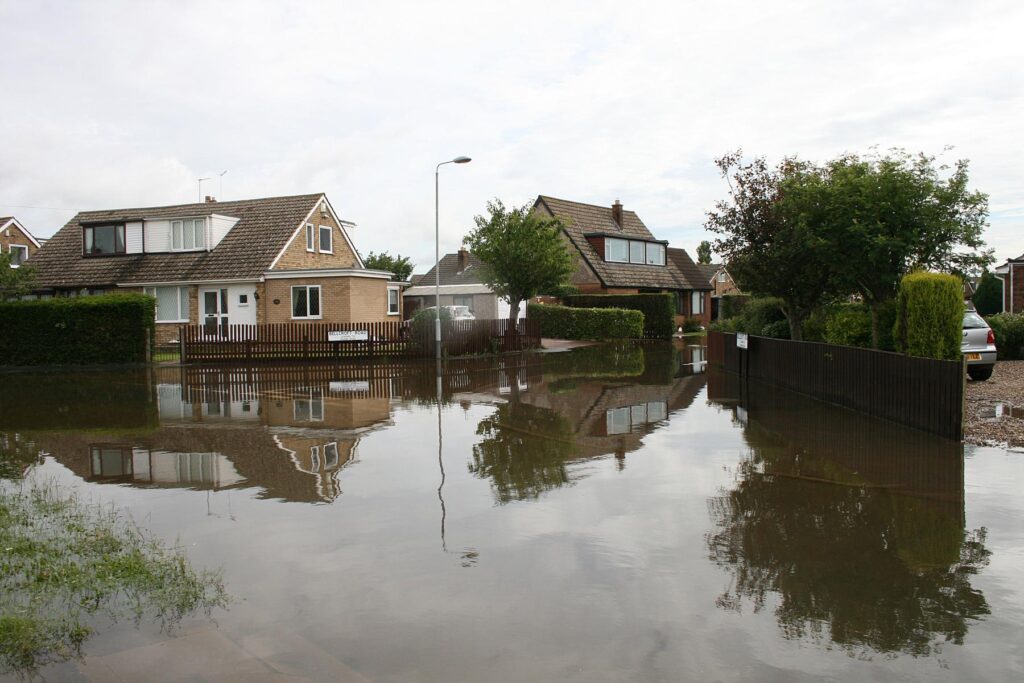
Contents
After a flood, you’re faced with the critical task of cleanup and mold prevention. It’s vital to assess the damage promptly and take safety precautions to protect yourself. Understanding the right tools and techniques can make a significant difference in how effectively you manage the situation. As you navigate through the initial steps, you’ll discover key strategies that can prevent future mold issues and ensure your home remains safe and healthy. What comes next?
Key Takeaways
- Immediately remove standing water using pumps or wet/dry vacuums to minimize damage and prevent mold growth.
- Document all damage with photos for insurance claims and assess which items can be salvaged or need discarding.
- Ensure proper ventilation and use dehumidifiers to control humidity levels and promote drying in affected areas.
- Clean and disinfect surfaces that come into contact with floodwater to prevent mold development and ensure safety.
- Regularly inspect for leaks and maintain cleanliness to eliminate mold spores and sources of moisture in your home.
Assessing the Damage After a Flood
After a flood, evaluating the damage is essential to determining the next steps for cleanup and recovery.
Start your damage assessment by thoroughly inspecting your property. Check for structural issues, such as cracks in walls or ceilings, and look for waterlogged materials. Document everything with photos and notes, as this information will be significant for insurance claims and future flood evaluations.
Pay close attention to areas most affected by water, like basements and crawl spaces. Mold can develop quickly in damp environments, so recognizing moisture levels is critical.
Identify items that can be salvaged and those that need to be discarded.
Safety Precautions Before Cleanup
Before starting cleanup, it’s essential to wear protective gear, including gloves, masks, and goggles, to shield yourself from contaminants.
Additionally, assess any electrical hazards, as water can compromise wiring and increase the risk of shock.
Taking these precautions ensures a safer environment as you tackle the aftermath of the flood.
Wear Protective Gear
When tackling flood cleanup, wearing protective gear is essential for your safety and well-being.
Floodwaters can contain harmful contaminants, so you need to ensure you’re adequately protected.
Here’s a quick checklist of gear you should consider:
- Protective masks: Prevent inhalation of mold spores and dust.
- Safety gloves: Shield your hands from sharp objects and bacteria.
- Waterproof boots: Keep your feet dry and safe from hazardous materials.
- Goggles: Protect your eyes from debris and chemicals.
- Long-sleeved clothing: Shield your skin from irritants and cuts.
Assess Electrical Hazards
Once you’re suited up in protective gear, the next step involves evaluating electrical hazards in your environment.
Begin with a thorough electrical inspection to identify any exposed wires or damaged outlets. Flooding can compromise electrical systems, making it essential to follow safety protocols.
Never assume that power is off; always check with a voltage tester before touching any electrical components. If you notice any issues, it’s best to contact a licensed electrician for assistance.
Avoid using appliances that may have been submerged, as they can pose serious risks.
Essential Tools and Supplies for Flood Cleanup
When tackling flood cleanup, having the right tools and supplies is vital for efficiency and safety.
You’ll need essential cleaning equipment such as mops, buckets, and wet vacs, along with protective gear like gloves and masks to shield yourself from contaminants.
Must-Have Cleaning Equipment
Effective flood cleanup requires a well-equipped toolkit, and having the right cleaning equipment can make a significant difference in restoring your space.
To help you create an effective equipment checklist, consider these must-have cleaning supplies:
- Wet/dry vacuum: Essential for removing excess water from floors and carpets.
- Mops and buckets: For scrubbing and sanitizing surfaces effectively.
- Brooms and dustpans: Useful for clearing debris and dirt.
- Scrub brushes: Ideal for tackling stubborn stains and mold.
- Disinfectants: Necessary for sanitizing surfaces to prevent mold growth.
Investing in these items will streamline your cleanup process and ensure a safer and healthier environment as you restore your home.
Protective Gear Essentials
Cleaning up after a flood can expose you to various hazards, making protective gear a significant component of your cleanup efforts.
Start by donning high-quality protective gloves to shield your hands from sharp objects, chemicals, and contaminants lurking in the debris. These gloves should be durable yet flexible, allowing you to maintain dexterity while working.
Safety goggles are another essential item; they protect your eyes from splashes and airborne particles, ensuring you can see clearly during the cleanup process. It’s important to choose goggles that fit snugly to prevent any gaps.
Together, these items enhance your safety and foster a sense of community as you tackle this challenging task, showing that you care for yourself and those around you.
Removing Standing Water Effectively
Act quickly to remove standing water, as delaying this critical step can lead to extensive damage and mold growth.
To effectively tackle this issue, you’ll want to use various water removal techniques and consider your pump options. Here are some strategies to guide you:
Submersible Pumps: Ideal for deep water collection, ensuring efficient removal.
Sump Pumps: Perfect for ongoing drainage in areas prone to flooding.
Wet/Dry Vacuums: Great for smaller puddles and debris removal.
Bailing: A manual method useful for limited water and tight spaces.
Natural Drainage: If safe, redirect water to low-lying areas to expedite removal.
Drying Out Your Home Thoroughly
Once you’ve removed standing water, drying out your home thoroughly is crucial to prevent mold growth and further damage.
Start by employing effective air circulation techniques. Open windows and doors to promote cross-ventilation and use fans to increase airflow throughout the affected areas. Aim to create a consistent breeze that helps evaporate residual moisture.
Next, implement moisture control methods. Use dehumidifiers to extract moisture from the air, particularly in enclosed spaces like basements and closets. Monitor humidity levels with a hygrometer, making sure they remain below 60%.
Additionally, remove any damp materials, such as carpets or furniture, that could harbor moisture. Keep an eye on hidden areas, like behind walls or under floors, where water might linger.
Cleaning and Sanitizing Affected Areas
With your home thoroughly dried out, the next step is to focus on cleaning and sanitizing the affected areas to eliminate any remaining contaminants.
This process is essential to prevent health risks and ensure your living space feels safe and welcoming again.
Here are some effective decontamination techniques you should employ:
- Use a mixture of water and detergent to clean hard surfaces.
- Disinfect surfaces with a solution of bleach and water (1:10 ratio).
- Pay special attention to fabrics; wash or replace items that can’t be cleaned effectively.
- Ventilate the area during cleaning to reduce odors and improve air quality.
- Seal any openings after cleaning to prevent future moisture buildup.
Identifying and Addressing Mold Growth
While it’s vital to clean and sanitize areas affected by flooding, identifying and addressing mold growth is equally important for maintaining a healthy home environment.
Mold types can vary considerably, with common varieties including black mold, Aspergillus, and Cladosporium. Knowing how to identify these types can help you take the right steps for remediation.
Detection methods are essential in pinpointing mold presence. You can visually inspect damp areas, looking for discoloration or a musty odor. Additionally, consider using moisture meters to check humidity levels, as high moisture is a breeding ground for mold.
If you suspect hidden mold, air sampling or surface testing may be necessary.
Act promptly; the sooner you address mold growth, the better you can protect your home and loved ones.
Taking these steps ensures you foster a safe environment where everyone can thrive, free from the risks associated with mold exposure.
Preventing Future Mold Issues
To effectively prevent future mold issues, it’s crucial to control humidity levels and ensure proper ventilation throughout your home.
High humidity creates the perfect breeding ground for mold, so incorporating mold-resistant materials can greatly enhance your home’s defenses.
Here are some key strategies to take into account:
- Install dehumidifiers in damp areas like basements.
- Verify exhaust fans are working in kitchens and bathrooms.
- Regularly check and repair leaks in plumbing and roofs.
- Use mold-resistant paints and drywall in moisture-prone areas.
- Keep indoor plants that can help absorb excess moisture.
When to Seek Professional Help
Knowing when to seek professional help is essential in managing mold issues effectively, especially if you encounter extensive growth or persistent moisture problems.
It’s vital to recognize the signs of damage—like water stains, musty odors, or visible mold—which indicate that the situation may be beyond your control. If you notice mold covering more than 10 square feet or if the affected area has been exposed to contaminated water, you should definitely consider when to hire a professional.
Professionals have the expertise and equipment to assess the situation accurately and ensure thorough remediation.
Additionally, if anyone in your household has respiratory issues or allergies, getting expert help can prevent health complications.
Trust your instincts; if you feel overwhelmed or uncertain about tackling the problem alone, reaching out for professional assistance is a wise choice that can protect your home and loved ones.
Review
Effective flood cleanup and mold prevention are crucial for safeguarding your home and health. Did you know that mold can begin to grow within 24 to 48 hours after water exposure? By promptly addressing water damage, using the right tools, and maintaining proper ventilation, you can greatly reduce the risk of mold growth. Stay proactive in monitoring your environment, and don’t hesitate to seek professional help if needed to ensure a safe, dry living space.
Recent Posts
Budget-Friendly Water Damage Restoration Tips
When water damage strikes, acting fast can save you time and money. You’ll want to
Bounce Back: Flood Cleanup and Mold Busters
It’s vital to act quickly and effectively after a flood. Understanding the right steps and
7 Best Flood Cleanup and Mold Prevention Tips
Many people underestimate the speed at which mold can develop after a flood, often within
